Entries in Kite Pioneers (5)
Bell's Tetrahedral Kite - Centennial Celebrations
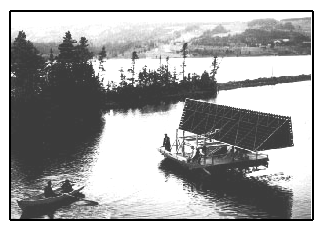 One hundred years ago, on December 6, 2007, Alexander Graham Bell launched his largest tetrahedral kite, the Cygnet II, over the waters of Bras d'Or lake in Cape Breton, Nova Scotia. Towed behind a steam powered boat and carrying Lieut. Thomas Selfridge as passenger and to some degree pilot, the Cygnet was a milestone in the history of the development of flight and one of the most significant events in Canadian kite history.
One hundred years ago, on December 6, 2007, Alexander Graham Bell launched his largest tetrahedral kite, the Cygnet II, over the waters of Bras d'Or lake in Cape Breton, Nova Scotia. Towed behind a steam powered boat and carrying Lieut. Thomas Selfridge as passenger and to some degree pilot, the Cygnet was a milestone in the history of the development of flight and one of the most significant events in Canadian kite history.
A great deal of attention is being paid to the tetrahedral kites of Dr. Bell during this centennial celebration year marking the historic flight of the huge Cygnet. It certainly is a time to pause and remember the amazing ingenuity of the era as humans searched for the best ways to lift people into the sky in a safe and controlled manner.
Bell's intention was to use the inherently strong tetrahedron as a building block for an 'aerodrome' (aircraft) that would eventually be powered by a gasoline engine and achieve independent flight under the control of a pilot.
The Halifax Chronicle Herald ran a feature story on the work of Bell's Aerial Experiment Association, a group of five engineer-scientist fellows. The group was funded with a $30,000 investment provided by Mabel Bell, Dr. Bell's wife, who acted as the group's Secretary-Treasurer.
Uplifting dream was born century ago
Within 18 months, Bell-led group had Silver Dart in Baddeck sky
By TERA CAMUS Cape Breton BureauThe ChronicleHerald.ca October 1, 2007
BADDECK — It was 100 years ago today when it all began.
High on the hill overlooking Baddeck Bay, Alexander Graham Bell invited four men to his estate to begin working on a dream that would literally take flight 18 months later, in 1909.
Backed with $30,000 from Mr. Bell’s wealthy socialite wife Mabel, five creative minds forged a partnership known as the Aerial Experiment Association after the famous, aging inventor convinced them they could take flight in an aircraft after experimenting with large kites on and over his Baddeck estate.
"It’s amazing to think that for thousands and thousands of years, we couldn’t fly and within 18 months, bang, we’re flying among the stars," Mr. Bell’s great-grandson, Hugh Bell Muller, told The Chronicle Herald inside the Kite House where the five men constructed the aircraft.
Mr. Muller and his wife still walk on the original floorboards of that former barn, now renovated into a comfortable home, where Alec Bell, as he was known locally, worked with British immigrant Douglas McCurdy, a resident of Baddeck, and Toronto’s Casey Baldwin, both expert engineers. He also invited United States Lt. Thomas Selfridge and Glenn Curtiss, a New Yorker who built engines.
All five men lived in "the big house," better known as Beinn Bhreagh, which now is only open in summers for Mr. Bell’s direct descendants.
"In Bell’s time, he knew all the scientists," Mr. Muller said. "As a kid, he dreamed about flying while watching the birds."
The Wright Brothers, who had proved an aircraft could lift off using a catapult method, were busy in the United States trying to understand how to maintain flight.
"Bell was concerned with two things, the first was safety and the other was stability of controls to maintain a flight," Mr. Muller said. "Ms. Bell told him: ‘The five of you get an airplane in that air’ and it took 18 months to get the Silver Dart."
The first aircraft built in the Kite House in 1907 was the Cygnet, but it had no engine. It carried Selfridge for seven minutes and 51 metres and "flew beautifully" before it crashed into the water below Mr. Bell’s estate.
Moving on from the Cygnet, Bell and the five members of the AEA built four powered airplanes that were stable and reliable in flight. The culminating aircraft was the famous "Silver Dart" which was the first airplane to fly in the British Commonwealth of Nations when it lifted off the frozen waters of Bras d'Or Lake on February 23, 1909.
During this centennial celebration year of the massive Cygnet kite, a special commemorative kite fly was organized by the Canadian Kite Federation/Federation Canadienne du Cerf-Volant amd the Drachen Foundation of Seattle WA. The event was held on the Bell estate at Beinn Bhreagh overlooking Bras d'Or Lake in Baddeck, Nova Scotia on August 21, 2007.
Gary Mark of CKF/FCCV and Scott Skinner of the Drachen Foundation were instrumental in putting together the kite fly tribute to Bell's work with the Cygnet kite. More information can be found in an excerpt from the web site of the Drachen Foundation. A terrific video of interviews with Gary Mark, principal organizer of the event, and Hugh Muller, great-grandson of Alexander Bell is found on a special video clip at YouTube. Another interesting video clip is the CBC-TV Newsworld live broadcast of the event, also at YouTube.
In the autumn of 2004, CBC ran a television series entitled: The Greatest Canadian. Alexander Graham Bell was one of the featured candidates for the title of the greatest Canadian. I had the privilege of working on the production of that television show along with my good friend Gary Mark. To read about that story you can see an earlier posting in the Best-Breezes blog that detailed Bell's tetrahedral kites and see how a kite was included in the video taping for the show.
In the web site section of Best-Breezes, you can find more detailed information on Bell's Cygnet kite, the aerodromes of the Aerial Experiment Association, and a variety of other references on Bell's work with kites and aircraft. Be sure to check out the article entitled: Alexander Graham Bell: After the Telephone - Tetrahedral Kites, Airplanes and Hydrofoils.
One hundred years later the memory of Alexander Graham Bell's giant tetrahedral kites still lifts the imagination and makes the spirit soar!
The Time it Took! A Timeline of Kite History
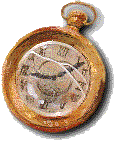 Time, it has been said, marches resolutely on and leaves a record of what has gone before if we are careful to observe.
Time, it has been said, marches resolutely on and leaves a record of what has gone before if we are careful to observe.
There are so many historical events over the course of time. The most recent events and happenings are well recorded and documented but can still be open to varying interpretation. The more distant events are harder to trace and often do not have many validating or corroborating sources of information. So it is with the history of the earth, of mankind, of cultures and nations, and of devices and inventions.
Several years ago, sixteen to be exact, I set out to puzzle out for myself a credible timeline of kite history. The purpose in my mind was simple: order the events and chronicle the people who had contributed to the development of the kite and used it in innovative and interesting ways. A simple task, I was sure.
Not so! Here I am sixteen years later publishing for the first time my efforts at recording a brief, and hopefully useful, chronology of the kite. I have postponed the publication of any of the timelines on this web site many times. I did this because I continued to find conflicting evidence about the order and timing of events. Revision, checking more sources, update and more revision became an ongoing state of affairs.
I believe that the timelines published here today are very accurate, but they are not infallible. As with any historical effort covering a broad scope there is room for error even with the most thorough checking of facts having been carried out.
I know that these timelines will need to be revised again and again as new information is brought forward and as conflicting evidence challenges details or dates.
I have published the timelines at this juncture because I believe in their accuracy. I know that the scrutiny of kiters and people with a deep interest in things historical will undoubtedly lead to challenges and the correction of possible errors. I welcome your input, your questions, your dialogue and your sharing of factual evidence. Only through such cooperative effort can a properly validated timeline of kite history be available for use by students in schools and for reference by kiters who would like to know more about the development of this amazing device, the kite.
To begin your journey through time and experience the chronicle of the kite, I invite you to visit the Best-Breezes Timeline of Kite History.
Please contact me if you wish more information, have questions or can suggest some sources or evidence to improve the timeline.
Bob White - Hifliercanada - October 30, 2006
_______________________________________
Captain Jean-Luc Picard:
"Time is a companion that goes with us on a journey. It reminds us to cherish each moment, because it will never come again. What we leave behind is not as important as how we have lived."
played by Patrick Stewart, from the film "Star Trek: Generations"
The Most Famous Kite Aerial Photographs of the Past 100 Years
The devastating earthquake of April 18, 1906 resulted in major loss of life and incredible structural and economic damage in the city of San Francisco, CA.
The earthquake was of a 7.9 magnitude on the Richter Scale. It lasted for over forty-five seconds and was followed by a series of strong after shocks. San Francisco was devastated. Over 3000 people lost their lives as a result of the earthquake. Fires broke out and fanned through the city consuming much of what was left standing.
Tens of thousands were left homeless. The United States Army established a tent city to house the destitute. The economy of the city and region was crushed. San Francisco immediately became the centre of attention of the world press.
It is said that this was one of the first national disasters to receive wide photographic coverage. Newspapers around the world printed some of the many photographs taken of the ruins and effects, all shot at ground level or from a few floors up in the few buildings left sound and standing.
The devastation drew the attention of all who saw the photos in newspapers around the globe.
However, a series of photographs taken seventeen days after the quake became famous for their pictorial effect in showing the wide spread and near complete ruin caused by the quake and the ensuring fires.
George Lawrence, a noted Chicago photographer who had pioneered aerial photography from captive hydrogen balloons in 1895, determined that he should travel to the west coast to record the catastrophe from the unique perspective of two thousand feet above the city.
 Lawrence was always seeking ways to improve the raising of his large aerial cameras and he became acquainted with Chicago inventor Silas Conyne, who had developed and patented the Conyne Kite to lift advertising banners in 1902. By 1904 Lawrence had developed a method of training a group of Conyne kites to lift his large, heavy cameras and to steady them in position to take aerial photographs.
Lawrence was always seeking ways to improve the raising of his large aerial cameras and he became acquainted with Chicago inventor Silas Conyne, who had developed and patented the Conyne Kite to lift advertising banners in 1902. By 1904 Lawrence had developed a method of training a group of Conyne kites to lift his large, heavy cameras and to steady them in position to take aerial photographs.
It was this "Kite Aerial Photography" system that Lawrence employed on May 5, 1906 to shoot his dramatic photos of the devastation of the San Francisco earthquake's primary damage zone.
Below is one of the several photographs that George Lawrence made to record the destruction of the San Francisco earthquake of April 18, 2006.

Arguably, these photos are the most famous kite aerial photographs produced in the past 100 years. Although there have been many advances in KAP (Kite Aerial Photography) no photos taken from the lofty platform provided by a kite have been more dramatic or of greater historical importance.
Lawrence's work is well documented. Originals of his photographic works are found in a number of museums, most notably the collections of the Chicago Historical Society, the Library of Congress and the National Archives of the United States of America.
Present Day Kite Aerial Photography of San Francisco and San Andreas Earthquake Zones:
Sometime during the next few weeks, Scott Haefner will attempt to reshoot the San Farncisco quake area using modern KAP techniques and equipment. Scott's project is being supported by The Drachen Foundation. You can follow this event on Scott Haefner's weblog.
The United States Geological Service has also used KAP as a tool to present aerial images of the San Andreas fault at the Carrizo Plain. Again, Scott Haefner, a noted KAPer, is involved in this intriguing project.
References:
Baker, Dr. Simon. "George Lawrence: A Giant in Kite Aerial Photography." Kitelines, Fol. 11, No. 1, Fall 1994. Pp. 52-55. [Images in this Best-Breezes Blog entry are reproduced by permission of Valerie Govig, Publisher, Kitelines.]
NewHall, Beaumont. Airborne Camera: The World from the Air and Outer Space. New York, N.Y. Hastings House Publishers in collaboration with the George Eastman House, Rochester N,Y. 1969 ISBN: 8038-0335-4 Pp. 43-46.
Notes:
- The first kite aerial photographs known were taken by Arthur Batut of France in 1889.
- William Abner Eddy of Bayonne, N.J. was the first in North America to take photographs from kites. Using trains of six to nine kites Eddy took photos of New York city and environs from heights of 1000 feet in 1895. This was at least four years before Lawrence began using any type of kite for aerial photography.
It's All About Ben - the electrifying kite flyer!
 January 17, 2006 is the 300th anniversary of the birth of Ben Franklin. You can definitely say that this year, the Tercentenary of Benjamin Franklin's birth, will be "..all about Ben.."!
January 17, 2006 is the 300th anniversary of the birth of Ben Franklin. You can definitely say that this year, the Tercentenary of Benjamin Franklin's birth, will be "..all about Ben.."!
Although kite fliers celebrate his kiting prowess, evident long before it was cool to be known as a kite flyer, there is more to Ben than a couple of dramatic events with kites.
Sure, he was daring enough to dangle a key from a wet cotton kite line as the kite itself danced in the electrically charged thunderclouds overhead. Truly a shocking thing for a kite flyer to do even if it was an attempt to prove a scientific theory. Today, we all pull our kites in at the first sign of approaching heavy weather since we are well aware of the inherent dangers of hanging on to a line as we stand on 'the ground' while our kite is gathering positive electrons in the upper air.
 We also applaud his dramatic use of a kite to pull him across a pond on a glorious summer day. To show his casual confidence and panache, Franklin attached the kite to his toe as the forces of kite traction were harnessed in an elegant manner. Surely reading this bit of history cannot be where Peter Lynn had his Eureka moment that led to kite boarding and his new "Kite-Cat"!
We also applaud his dramatic use of a kite to pull him across a pond on a glorious summer day. To show his casual confidence and panache, Franklin attached the kite to his toe as the forces of kite traction were harnessed in an elegant manner. Surely reading this bit of history cannot be where Peter Lynn had his Eureka moment that led to kite boarding and his new "Kite-Cat"!
Yes, indeed, Benjamin Franklin does inspire we modern day kiters.
However, 2006 is all about Ben for more than the kite related escapades that we revere. This year Ben is celebrated because of his huge contributions to so many innovations and principles that we take for granted today.
To properly celebrate his genius, achievements, inspirational leadership and legacy a special foundation was created. The Benjamin Franklin Tercentenary is a private, non-profit alliance established to mark the three-hundred-year anniversary of Benjamin Franklin’s birth (1706-2006) with a celebration dedicated to educating the public about Franklin’s enduring contributions and inspiring renewed appreciation of the values he embodied.
So, as much as we kite enthusiasts would like to celebrate him as a brilliant man who saw the virtues of being a kite flyer, we have to be realistic and acknowledge that his claim to fame and his impact on his times was founded on more than his kite adventures.
 For a great review of Benjamin Franklin's life through the lens of a kite historian, visit Margaret Robinson's thorough article on his life and contributions. Entitled "Kites in the Age of Reason". The article was originally published in KITING, The Journal of the American Kitefliers Association, Spring 2002, Volume 24, Issue 1. Meg gives a detailed outline of his life and places due emphasis, for kite afficionados, on Franklin's use of the kite in pursuit of theories of electricity in an age when all of these concepts were just being explored.
For a great review of Benjamin Franklin's life through the lens of a kite historian, visit Margaret Robinson's thorough article on his life and contributions. Entitled "Kites in the Age of Reason". The article was originally published in KITING, The Journal of the American Kitefliers Association, Spring 2002, Volume 24, Issue 1. Meg gives a detailed outline of his life and places due emphasis, for kite afficionados, on Franklin's use of the kite in pursuit of theories of electricity in an age when all of these concepts were just being explored.
Of particular interest to kiters is the web page entitled simply "Franklin's Kite" Here we can see in a laboratory setting how kites can attract electricity and the rather dramatic effects of the spark. In particular, it is worth downloading the video clip of a kite being struck by simulated lightning. If ever you doubted the safety reasons behind getting your kite out of a bad weather sky, this will 'charge' you to think again!
Now, just when we were pleased that such a notable person as Ben Franklin used a kite in the famous electricity experiment, I have to rudely tug on your kite line. Tom Tucker, in his 2003 book Bolt of Fate: Benjamin Franklin and His Fabulous Kite, strikes out at the notion that Franklin actually conducted his celebrated experiment with the kite and lightning. Dr. Tucker, a lecturer and historian at the Isothermal Technical College in North Carolina, first began to suspect the story while working for NASA. Tucker examined the original documents, and found that accounts by Franklin were vague about when and where the experiment was performed. He then went on to try to replicate the experiment, safely of course, using materials available in the mid-18th century.
 Dr. Tucker finally concluded that it could not have been done. Tucker stated: "I followed the design of the kite and tried it several times - and it just wouldn't fly." ... "Even if it had, there was no way it could have reached the heights needed to draw electricity from thunderclouds." (See: "Benjamin Franklin 'faked kite experiment' - based on an interview with Dr. Tom Tucker by Robet Matthews, Science Correspondent, London Telegraph.)
Dr. Tucker finally concluded that it could not have been done. Tucker stated: "I followed the design of the kite and tried it several times - and it just wouldn't fly." ... "Even if it had, there was no way it could have reached the heights needed to draw electricity from thunderclouds." (See: "Benjamin Franklin 'faked kite experiment' - based on an interview with Dr. Tom Tucker by Robet Matthews, Science Correspondent, London Telegraph.)
Now that is something to contemplate. Tucker goes on to conclude that Franklin's scientific theories about electrical energy in the atmosphere were academically sound. Small comfort for kite fliers who see one of our iconic kite pioneers challenged in such a way.
It has been said that Benjamin Franklin is one of the most significant figures in history. Certainly, judging by the vast array of books about his life and accomplishments, it must be true. Many noted historical biographers have written fascinating and detailed accounts about him. During the Franklin Tercentenary it will be possible to learn a good deal more about his life. Major documentaries, travelling exhibitions, and numerous journal articles will be easily available for your enlightenment. Just reading all of the entries served up in a Google search could prevent a kite flyer from ever having time to attend a kite festival this year.
Those of you who are kite builders might want to build a kite just like the one that Ben supposedly used in 1752. PBS, in their web site devoted to Benjamin Franklin, show how to build a kite like Franklin's in detailed steps using materials similar to those available inthe era. Now that is a worthwhile tribute to one of our earliest kite pioneers in this year that is '... all about Ben!'
References and Resources:
Asimov, Isaac. The Kite That Won the Revolution. Boston: Houghton Mifflin Co., 1963.
Van Doren, Carl. Benjamin Franklin (1st Ed.). New York: The Viking Press, October 1938.
Eden, Maxwell. Kiteworks: Explorations in Kite Building and Flying (1st Ed.). New York: Sterling Publishing Inc., 1989.
Fay, Bernard. Franklin, The Apostle of Modern Times (1st Ed.). Boston: Little Brown & Co. November 1929.
Hart, Clive. Kites: An Historical Survey. New York: Frederick A. Praeger Publishers, (c) 1967.
Larsen, Egon. Ideas and Invention. London: Spring Books, 1960.
Yolen, Jane. World on a String: The Story of Kites (1st Ed.). New York: World Publishing Co., 1968.
Ellis, Steven. "What Didn't Ben Franklin Do?" Web site of The Christian Science Monitor. Jan. 16, 1006.
Filming the Flight of the Bell Tetrahedral Kite for CBC-TV
Filming the Flight of the Bell Tetrahedral Kite for CBC-TV
Alexander Graham Bell - "The Greatest Canadian!"
As part of the TV documentary series "The Greatest Canadian", CBC-TV required a Bell tetrahedral kite as a visual prop to explain some of Alexander Graham Bell's work in early aviation.
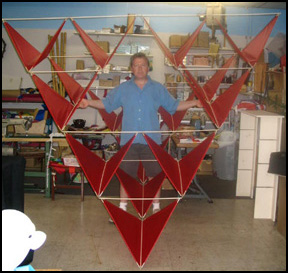 A 16 cell tetrahedral kite was built by Morris Canning of Parrsboro, NS (shown left) to be used in the segment about Bell's kites. The remainder of the story of Bell's use of kites is revealed through the use of archival photos from the A.G. Bell Museum in Baddeck, NS.
A 16 cell tetrahedral kite was built by Morris Canning of Parrsboro, NS (shown left) to be used in the segment about Bell's kites. The remainder of the story of Bell's use of kites is revealed through the use of archival photos from the A.G. Bell Museum in Baddeck, NS.
I was contacted in late July of 2004 by Patti-Ann Finlay, a CBC researcher assigned to the project, to discuss the role of tetrahedral kites and possibly build one for the documentary. My commitments to our local kite festival prevented me from actually building the kite. So Morris Canning undertook the construction of the kite and shipped it to me for my work with the CBC documentary crew. It was my task to assemble it, test fly it, teach CBC on-air staff to fly the kite and manage its use within the documentary.
The opportunity to work on a project like this would be exciting to any kiter and I eagerly entered into the project. Patti-Ann and I consulted on the phone on a number of occasions.
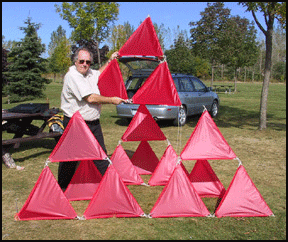 The kite that Morris built arrived on September 24th. It is an elegantly constructed kite and Morris clearly is a very fine kite builder. The complicated corner connections on the kite are nicely made out of vinyl tubing. They are surprisingly effective at giving the kite structural integrity at the complicated joints of tetra cells. The spars are of 3/16" hardwood dowel which make them light, yet reasonably strong. The sails are of red ripstop and they are very nicely sewn. Red was chosen to emulate the red silk used by Bell in his tetrahedral kite experiments at Beinn Bhreagh in Baddeck, N.S.
The kite that Morris built arrived on September 24th. It is an elegantly constructed kite and Morris clearly is a very fine kite builder. The complicated corner connections on the kite are nicely made out of vinyl tubing. They are surprisingly effective at giving the kite structural integrity at the complicated joints of tetra cells. The spars are of 3/16" hardwood dowel which make them light, yet reasonably strong. The sails are of red ripstop and they are very nicely sewn. Red was chosen to emulate the red silk used by Bell in his tetrahedral kite experiments at Beinn Bhreagh in Baddeck, N.S.
The date of filming was set for Thursday, September 30, 2004 at Milliken Park in the borough of Scarborough, city of Toronto. Upon my arrival at 11:00 a.m., I set up two perimeter wind ribbons on twenty foot telescoping poles to help us determine wind direction and speed during the takes for the flight sequence. Winds were light and intermittent. However, when there was a bit of wind it seemed that we would be able to carry out the flights according to plan.
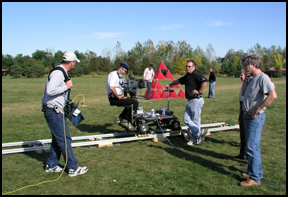 I completed the assembly of the kite and staked it to the ground to avoid an unwanted lift off. The setup of the film equipment was undertaken by CBC's technicians. It was at that moment that I realized the complexity of the task. The camera crew required a ninety foot track to be set up for their camera sled to ensure smooth filming as they provided motion and panning to the shots. Immediately I worried about the variability of wind direction. It was no easy task to set up the track, camera and sound equipment and if the wind did not hold in the general direction of the established layout we would be in serious trouble.
I completed the assembly of the kite and staked it to the ground to avoid an unwanted lift off. The setup of the film equipment was undertaken by CBC's technicians. It was at that moment that I realized the complexity of the task. The camera crew required a ninety foot track to be set up for their camera sled to ensure smooth filming as they provided motion and panning to the shots. Immediately I worried about the variability of wind direction. It was no easy task to set up the track, camera and sound equipment and if the wind did not hold in the general direction of the established layout we would be in serious trouble.
Ask any kite flyer about constant wind direction and they will tell you that there are no guarantees. There may be prevailing winds and there may be on-shore/off-shore wind conditions that are typical, but there are no guarantees on constancy of wind direction for any one day or period in a day. I was quietly worried.
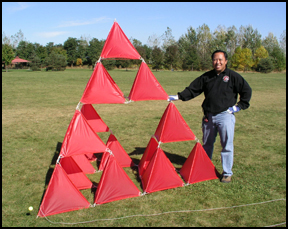 At about 12:30 p.m. my good friend Gary Mark of TKF arrived to take some photos of the event as well as to lend some encouragement and support. It was not long before Gary was an active and involved member of the kite crew and a highly valuable additional resource consultant. We decided that a test flight would be useful since I had only flown the kite in a four cell configuration to check some basic flight characteristics. I had never actually handled Morris' tetrahedral in its full sixteen cell configuration.
At about 12:30 p.m. my good friend Gary Mark of TKF arrived to take some photos of the event as well as to lend some encouragement and support. It was not long before Gary was an active and involved member of the kite crew and a highly valuable additional resource consultant. We decided that a test flight would be useful since I had only flown the kite in a four cell configuration to check some basic flight characteristics. I had never actually handled Morris' tetrahedral in its full sixteen cell configuration.
We walked the kite out for a very long launch due to the light wind conditions. So far so good - the wind direction remained aligned with the camera track location.
A tug, a few backward steps after Gary hand launched the kite and the kite was airborne. The kite climbed quickly and steadily and lofted into a stable position. Spontaneously the crew, director and management team broke into applause. The kite hung there for a few seconds and then the breeze died and I reeled in as quickly as possible to keep tension on the kite and bring it in for a soft landing. Gary broke into a sprint to soften the impact of the kite on the ground. He demonstrated good speed and agility and assisted the landing nicely.
Morris Canning constructed the kite lightly, but well. His intention, I figured, was to ensure good balance and provide a light enough framing structure to ensure easy flight in lighter winds. That was a good decision for we did not have strong winds during the day. Generally top wind speed, when the wind was up, was estimated at about 10-12 km per hour. Fequently it was much lighter than that and flying the kite required some vigorous pulling in of line to maintain elevation for the brief ninety second vidoe sequence .
Morris likely did not realize that we would have to accomplish about 15 flights during the day to ensure a good take for use in the documentary. All of the flights required some skilled line handling on the bridle and frame for launch. In addition delicate landings were necessary when the winds failed.
To ensure that the kite frame would not break we raced out to grab the kite and prevent it from dashing into the ground on each occasion. Gary Mark demonstrated 'great wheels' and proved that he is considerably younger and fitter than I am. Gary was assisted by Patti-Ann Finlay and Andre Czernohorsky of CBC. Great 'saves' were made on a number of occasions. However, there were a few crunches resulting in some broken spars. In addition, launching the kite seemed to put a good deal of strain on the frame and a few spars were broken at the start of some of the flights.
Each break required some disassembly of the kite to get at the cell that suffered the damage. Spar repairs were made, reassembly accomplished and subsequent "takes" were set up. As everyone knows, the Director wants to have several choices on tape from which to make a final selection.
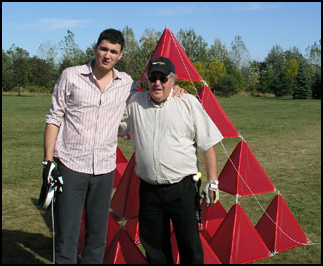 In all, we did ten takes of on-screen narrator Evan Soloman of CBC Newsworld explaining the features of the tetrahedral kite, Bell's reasons for choosing the tetrahedral structure, and a demonstration flight. The kite performed well each time.
In all, we did ten takes of on-screen narrator Evan Soloman of CBC Newsworld explaining the features of the tetrahedral kite, Bell's reasons for choosing the tetrahedral structure, and a demonstration flight. The kite performed well each time.
At the end of shooting the sequence with dialogue we readied the kite for one final flight with Evan not doing any narration. The purpose for the final flight was to get some unusual camera angles of the kite and Evan as the kite flyer. It was thought that these flight sequences might be used when the credits are shown for the documentary.
Following a long flight sequence the camera crew were satisfied and, on cue, the light winds died and the kite dropped. This time a few broken spars ensured that I would have some work at home to put it back in pristine condition. However, it had done it's job and Morris' fine version of the tetrahedral more than stood up to the rigorous multi-flight test.
The sequence will be part of the Bell documentary to air on November 15, 2004. For more information on "The Greatest Canadian" series, visit the CBC site dedicated to the project. Within the overall site on the series is a section devoted to Alexander Graham Bell.
My appreciation is extended to Patty-Ann Finlay of CBC-TV for including me in the work on this project. My hat is off to Morris Canning for his kite building skills and my good friend Gary Mark of Oakville, ON for helping out with his fine flying skills. Thanks also to host Evan Soloman and the entire crew for making Gary and I feel so special and involved. It was truly an interesting day of kiting!





